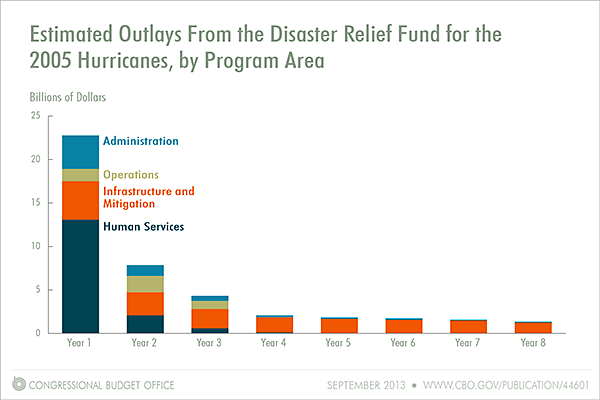Congress passed two major pieces of legislation providing tax relief to victims of the hurricanes that struck the Gulf Coast in the fall of 2005. The Katrina Emergency Tax Relief Act of 2005 (KETRA) established tax incentives to provide relief to Hurricane Katrina victims and stimulate donations to relief efforts. The Gulf Opportunity Zone Act of 2005 extended KETRA incentives to areas affected by Hurricanes Rita and Wilma and created additional tax incentives to support the economic recovery of the region, dubbed the Gulf Opportunity Zone (GO Zone). The Joint Committee on Taxation estimates that, from 2006 to 2010, KETRA and the Gulf Opportunity Zone Act will cost $6.1 billion and $7.8 billion, respectively.
- A substantial portion of the Gulf Opportunity Zone Act consists of establishing tax incentives to encourage the economic recovery of the areas affected by Hurricanes Katrina, Rita, and Wilma. These provisions will cost an estimated $3.4 billion from 2006 to 2010.
- States (Alabama, Florida, Louisiana, Mississippi and Texas) and localities in the GO Zone may issue tax-exempt private activity bonds to finance the construction or rehabilitation of real property by private individuals. States in the GO Zone may also issue Gulf Tax Credit Bonds that give bondholders federal income tax credits in place of interest payments.
- The bill modifies the Low-Income Housing Tax Credit for states in the GO Zone. Each state receives an additional credit allocation of $18 per state GO Zone resident. The GO Zone is considered a difficult development area, raising each project’s credit to 130 percent of eligible costs (rather than 100 percent).
- The act expanded the Hope and Lifetime Learning Credits for students attending educational institutions in the GO Zone. The maximum Hope credit increased from $2,000 to $3,000 and the maximum Lifetime Learning credit doubled to $4,000.
Several provisions grant tax relief to individuals who lived in the areas affected by Hurricanes Katrina, Rita, and Wilma prior to the storms and/or sustained economic loss as a result of the storms. In all, tax incentives targeting these individuals are estimated to cost $6.4 billion from 2006 to 2010.
Affected individuals could withdraw up to $100,000 from retirement plans through the end of 2006 without incurring the 10 percent early withdrawal penalty. Distributions could be included in taxable income ratably over the next three years, and any amounts recontributed during the period would not count as taxable income. Additionally, taxpayers could recontribute without tax or penalty withdrawals made to finance a home purchase that was cancelled due to one of the hurricanes.
Under ordinary circumstances, forgiven debt (such as the cancellation of a mortgage) counts as taxable income. KETRA excluded the discharge of non-business debt from taxable income for individuals affected by Hurricane Katrina. Similarly, insurance proceeds from damaged property are taxable income if they are not reinvested within two years. KETRA lengthened the replacement period to five years for individuals living in the Katrina disaster area.
The acts allowed affected taxpayers to deduct in full personal casualty or theft losses caused by the hurricanes; such losses are typically deductible only to the extent that they exceed $100 and 10 percent of adjusted gross income.
The bills waived the first-time homebuyer requirement to qualify for below-market rate mortgages from state and local governments for hurricane victims.
GO Zone residents who experienced a loss of income as a result of the storms could calculate their 2005 earned income and child tax credits based on their 2004 income.
The bills grant tax relief to businesses in the areas affected by the storms at an estimated 2006-2010 cost of $3.1 billion.
KETRA expanded the Work Opportunity Tax Credit to include individuals living in the Katrina disaster area. Employers could claim the credit–40 percent of the first $6,000 qualified wages per employee–against wages paid to workers hired during the two years following Katrina.
Businesses that retained employees hired before the hurricanes could claim an employee retention credit equal to 40 percent of the first $6,000 in wages paid per employee before the end of 2005.
Businesses could claim an additional first-year depreciation deduction, on both the regular tax and the AMT, of 50 percent of the cost of new property investments made in the GO Zone.
The net operating loss carry-back period is extended to 5 years on deductions for property losses caused by Hurricane Katrina, and carry-backs may be used to offset 100 percent of AMT income (as opposed to the standard 90 percent.
The legislation offered incentives for charitable giving at a cost of $1 billion from 2006 to 2010.
The act waived deduction limits on 2005 contributions by individual or corporations for hurricane relief efforts. (Ordinarily, individuals may deduct contributions up to 50 percent of adjusted gross income, while corporations face a 10 percent limit.)
KETRA provided taxpayers who housed people displaced by Hurricane Katrina with an additional $500 personal exemption for each such person. Taxpayers could claim the additional exemption for only one year—either 2005 or 2006—and the total exemption claimed could not exceed $2,000.
















